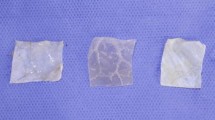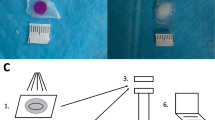Summary
Object. Numerous types of materials have been evaluated over the past decades in the quest for the ideal dural replacement, but no product fully meets all the applicable criteria. This paper presents the long-term results of an animal trial of a collagen biomatrix (TISSUDURA™, Baxter AG, Vienna/Austria) for the repair and regeneration of dural defects. This product provides a matrix with a special layer structure and consists of pure naturally cross-linked collagen of equine origin. The comparable material is Tutoplast Dura®, a human cadaveric-derived dural graft preserved in a multiple stage chemical process.
Methods. Bihemispheric parietotoccipital dural defects of a defined size were induced in 25 sheep and subsequently closed with the collagen graft or Tutoplast Dura®, respectively.
Results. Postoperative neurological abnormalities did not occur in any animal. There were no signs of graft rejection or formation of cerebrospinal fluid fistulae. The collagen graft site displayed histological signs as early as 2 weeks postoperatively consistent with a moderate Iymphocytic inflammatory response and infiltration with fibroblasts and macrophages. The graft subsequently developed a neodura-like connective tissue architecture. The Tutoplast Dura® showed only minimal cellular infiltration, and again the surrounding structures displayed a mild inflammatory response. 24 weeks postoperatively, the dura and neomembrane were barely distinguishable at the collagen biomatrix site, but the Tutoplast Dura® displayed inadequate fusion with the dural border and was encapsulated in a connective tissue layer.
Conclusion. The outcomes demonstrate that the collagen graft can be used for dura reconstruction as a temporary dural replacement and at the same time as a biomatrix for dural regeneration.
Similar content being viewed by others
Author information
Authors and Affiliations
Rights and permissions
About this article
Cite this article
Knopp, U., Christmann, F., Reusche, E. et al. A new collagen biomatrix of equine origin versus a cadaveric dura graft for the repair of dural defects – a comparative animal experimental study. Acta Neurochir (Wien) 147, 877–887 (2005). https://doi.org/10.1007/s00701-005-0552-0
Received:
Accepted:
Published:
Issue Date:
DOI: https://doi.org/10.1007/s00701-005-0552-0




